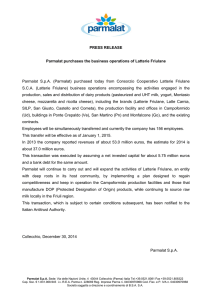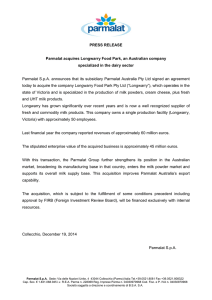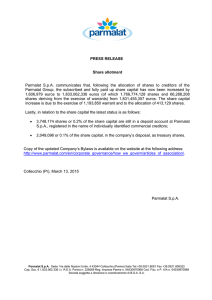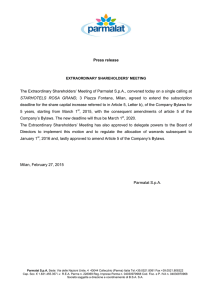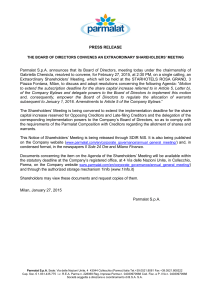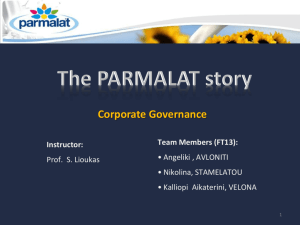PARMALAT CASE
advertisement
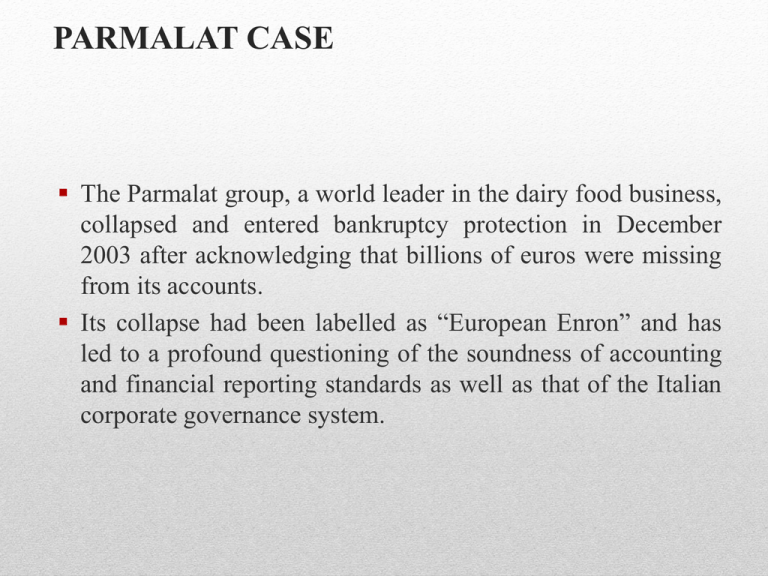
PARMALAT CASE The Parmalat group, a world leader in the dairy food business, collapsed and entered bankruptcy protection in December 2003 after acknowledging that billions of euros were missing from its accounts. Its collapse had been labelled as “European Enron” and has led to a profound questioning of the soundness of accounting and financial reporting standards as well as that of the Italian corporate governance system. PARMALAT CASE The Parmalat case epitomizes the most important problem traditionally associated with continental European governance structures, namely a controlling shareholder that exploits the company rather than monitoring its managers. Parmalat’s management structure was openly deficient, unlike Enron’s, which apparently was well designed. Despite this deficiency, Parmalat enjoyed an investment grade credit-rating, and was able to borrow increasing amounts of capital from investors. PARMALAT CASE Parmalat’s collapse It had been suggested (Financial Times, 22 December 2003: 18) that part of the problem was that Parmalat was a familyowned business and its operations were opaque, even though it had had a listing on the Milan stock exchange since 1987. Parmalat financial problems can be traced back a number of years before 2003, yet the group had apparently managed to convince banks, investors, financial regulators and the public that it was a healthy company. PARMALAT CASE Parmalat’s collapse • However, as events unfolded in the months following the December 2003 collapse, it emerged that concerns were being expressed several months before the collapse. • One of the features of the Parmalat Group was its complicated organizational structure, including over 170 subsidiaries. • Substantial funds were moved between these subsidiaries, some of which were registered in the Cayman Islands, a tax heaven, thus increasing the difficulty of monitoring cash flows and assets. Early on in the investigation, prosecutors were helped by a Parmalat employee who had disobeyed instructions to destroy sensitive documents and had handed over a computer and disks to investigators. As the investigation got under way, it was found that Parmalat had established a network of subsidiaries through which it had been able to channel substantial amounts of financial resources. It proved difficult for the administrator to establish the full extent of these offshore transactions. PARMALAT CASE Parmalat’s collapse By August 2004, Enrico Bondi had decided to extend his legal actions against some of the banks who had assisted Parmalat in issuing bonds and loans. It was revealed that the administrator was pursuing Deutsche Bank, USB and Citygroup for substantial compensation. Enrico Bondi and Italian prosecutors believed that Deutsche Bank, Bank of America, Citygroup, USB and some other financial institutions had been aware of Parmalat’s weak financial position before it finally collapsed in December 2003. PARMALAT CASE Parmalat’s collapse • All Parmalat’s financial statements had been falsified for a long time, although it is still not clear from exactly when. Both the poor performance of the core business and the exceptional amount of cash siphoned off by the Tanzi family over the years, when combined with the terrible results of the tourism business and the other activities of the Tanzi family (e.g., the football business), had created a mountain of debt that went out of control. PARMALAT CASE The Fraud Parmalat hid losses, overstated assets or recorded nonexistent assets, understated its debt, and diverted company cash to Tanzi family members. In order to hit losses, Parmalat had used various whollyowned entities, amongst which, the most significant was Bonlat, the Cayman Islands subsidiary of the Group existing during its final five years, and the holder of the Bank of America’s false account. Typically, uncollectible receivables were transferred from the operating companies to nominee entities, where their real value was hidden. PARMALAT CASE The Fraud Fictitious trades and financial transactions were organized to offset losses of operating subsidiaries and to inflate assets and incomes. Securitization schemes based on false trade receivables and duplicate invoices were recurrently used to finance the group. Parmalat understated its debt through different fraudulent schemes: it recorded non-existent repurchases of bonds, it sold receivables falsely described as non-recourse, in order to remove the liabilities from the records. PARMALAT CASE The Fraud The Milan Stock Exchange’s listing rules require listed companies to illustrate their corporate governance system. Those companies that have decided not to follow the Corporate Governance Code’s recommendations, issued by Borsa Italiana in 1999 and emended in 2002, have to justify this choice. The Code recommends the appointment of independent directors, a concept which is loosely defined and frequently misunderstood in practice. PARMALAT CASE Parmalat Board’s of Director In its first report, dated 2001, Parmalat declared that four of its thirteen directors were independent, but did not mention the relevant names. It gave the names in 2002. As far as 2003 is concerned, amongst Parmalat’s thirteen directors, eight were executives: they were Calisto Tanzi (CEO) and his son Stefano, his brother Giovanni, his nephew Paola Visconti, the company’s CFO Fausto Tonna and the top managers Luciano Del Soldato, Alberto Ferraris, and Francesco Giuffredi. PARMALAT CASE Parmalat Board’s of Director PARMALAT CASE Parmalat Board’s of Director • It is clear that during Parmalat’s history non-executive directors had never supervised managers. • The complexities of the group’s structure and finance required a great amount of work and financial understanding, and the non-executive directors were not prepared to dig into Parmalat’s intricate business. They probably relied on Tanzi. As with Enron, the Parmalat case demonstrates a clear case of gatekeeper failure. Within the Parmalat group the most important reputational intermediaries that acted as gatekeepers were the board of statutory auditors, the external auditing firm, and the internal control committee. In the Enron case, not only did senior management take advantage of US accounting standards’ limitations to manage its earnings and balance sheet, but also its financial statements did not conform to existing US GAAP.. PARMALAT CASE The Failure of the Gatekeepers PARMALAT CASE The Failure of the Gatekeepers • This differentiates the Parmalat case from its American counterpart. Few accounting issues were found at Parmalat. There is little evidence that Parmalat’s financial statements violated the letter of the adopted accounting standards, although they clearly violated the overall “spirit”, since the overriding “true and fair view” objective was not pursued. PARMALAT CASE Political reactions to the Parmalat scandal The Parmalat scandal is the subject of political debate concerning the distribution of power amongst Italian supervisors. The Bank of Italy was attacked for not having screened Parmalat’s issues on the bond market under Article 129 of the Consolidated Banking Law. It was also criticized for failing to discover the true nature of the information provided by Parmalat regarding its debt, given that the Bank of Italy manages the so-called “Centrale Rischi”, a data bank that classifies bank debts. PARMALAT CASE Political reactions to the Parmalat scandal • The Italian Parliament created a joint committee for the analysis of the Parmalat collapse and the drafting of a new law concerning capital markets, a sort of Italian Sarbanes-Oxley Act. PARMALAT CASE Political response The political response to the Parmalat scandal was overshadowed when another scandal hit Italy: the BPI affair, concerning an alleged concert action orchestrated by Banca Popolare Italiana (BPI) in order to gain control of Banca AntonVeneta, defeating a bid by ABN Amro. This scandal was eventually to bring down the Bank of Italy’s Governor, Antonio Fazio, who was accused of favouring BPI and, in particular, its chief executive, Giampiero Fiorani. PARMALAT CASE Political response • The B.P.I. scandal had allegedly launched (with a cohort of conspirators) large insider trading operations when its own bank undertook large capital markets transactions. The Italian Parliament under pressure again and close to the end of its term, enacted a new law (28 December 2005, No. 262) that can be seen as an equivalent of the Sarbanes-Oxley Act. EVALUATING REGULATORY RESPONSES: THE US AND THE UK It is interesting to consider various reforms, both actual and proposed, that have been prescribed in the Anglo-American context. At the core of this discussion must necessarily be the Sarbanes-Oxley Act. It is necessary to understand the three regulatory mechanisms that are at the core of the post-Enron reform debate: 1. Strengthening shareholder rights 2. The reform of accounting regulation 3. Increasing the role played by non-executive (or “outside”) directors. REFORMING EU COMPANY LAW AND SECURITIES REGULATION In addition to difficulties generated by the issues that have proved controversial in the US, the European reform agenda faces several unique challenges. The most fundamental stems from the fact that the EU encompasses a diversity of systems of corporate governance. There is a divide between the UK’s “outsider” share ownership and the “insider” share ownership of continental Europe, with a corresponding difference in the emphasis of regulation between rendering management accountable and keeping blockholders under control. In the spring of 2002, even before any problems had surfaced at Parmalat, the European Commission asked their High-Level Company Law Expert Group to prepare a report elaborating any necessary EU legislation in the field of corporate governance. A particularly important issue for the High-Level Group concerned the role and structure of the board of directors, the relevant proposals for which have now been incorporated into a Commission Recommendation. REFORMING EU COMPANY LAW AND SECURITIES REGULATION The Expert Group/Action Plan’s philosophy of focusing legislative energies on core issues for which consensus might be achieved, and the greater use of non-binding recommendations, can be seen as part of an emerging trend. European policymakers are becoming both more sensitive to the different capabilities of various regulatory techniques both to overcome political obstacles and to achieve regulatory goals. In Europe, the scandals have provided the impetus for surmounting political obstacles to the reform of corporate and securities law at the EU level. REFORMING EU COMPANY LAW AND SECURITIES REGULATION
